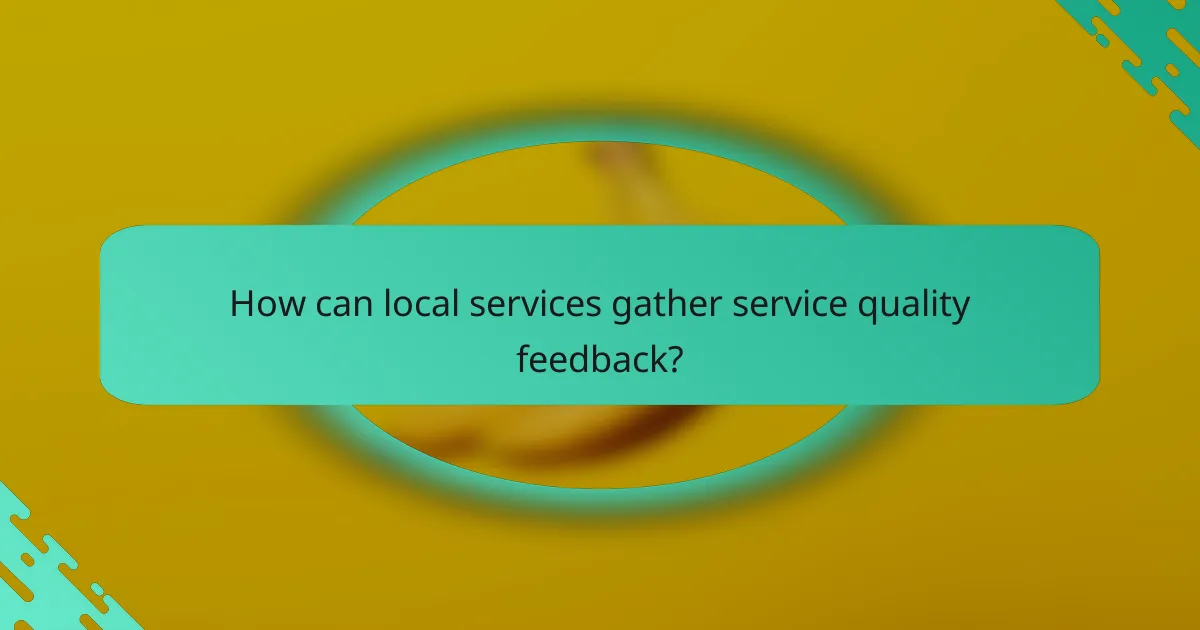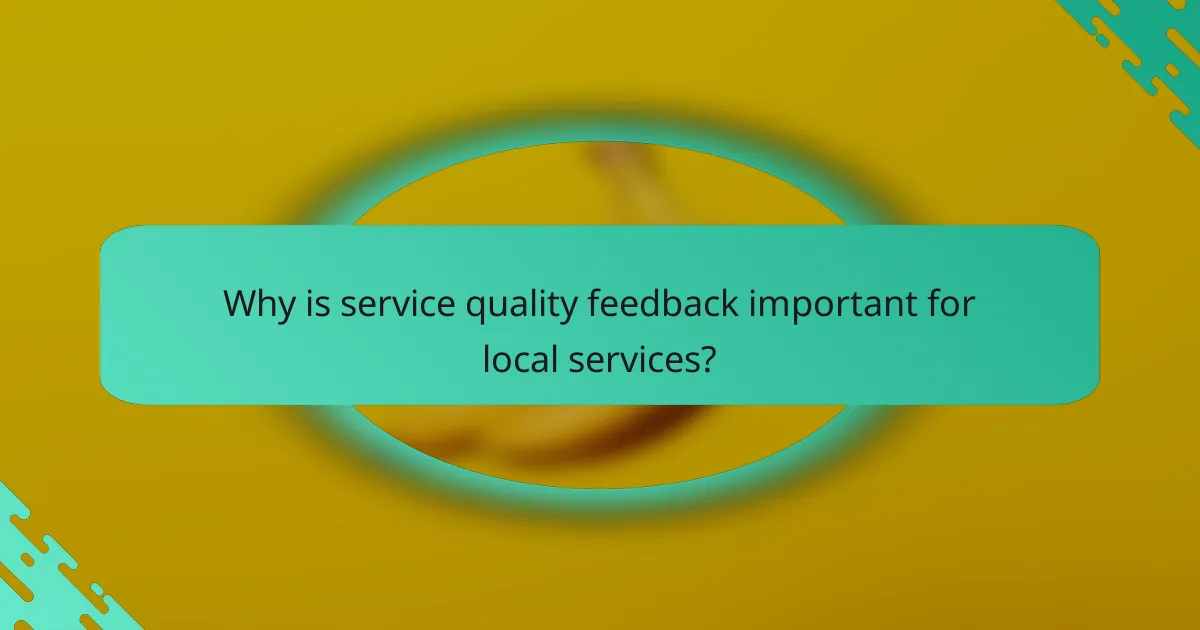Collecting service quality feedback is essential for local services to enhance customer satisfaction and identify areas for improvement. By utilizing various channels for direct communication, businesses can gain valuable insights into customer experiences and expectations. Implementing best practices, such as timing requests appropriately and ensuring respondent anonymity, can lead to more accurate and honest feedback, ultimately driving service quality enhancements.

How can local services gather service quality feedback?
Local services can gather service quality feedback through various channels that facilitate direct communication with customers. These methods help businesses understand customer experiences and identify areas for improvement.
Online surveys
Online surveys are a popular method for collecting service quality feedback due to their convenience and accessibility. Services can create short surveys using platforms like SurveyMonkey or Google Forms, allowing customers to provide insights at their convenience.
To maximize response rates, keep surveys brief, focusing on key aspects of service quality. Offering incentives, such as discounts or entry into a prize draw, can also encourage participation.
In-person interviews
In-person interviews provide an opportunity for deeper insights into customer experiences. Conducting these interviews in a comfortable setting allows customers to share detailed feedback about their interactions with the service.
When planning interviews, prepare open-ended questions to encourage discussion. Aim for a diverse range of participants to capture various perspectives, and consider scheduling these interviews during peak service hours for higher availability.
Social media polls
Social media polls are an effective way to engage customers and gather quick feedback on service quality. Platforms like Facebook and Instagram allow businesses to create simple polls that can reach a broad audience.
Keep polls concise, focusing on specific aspects of service quality. Regularly posting polls can help track changes in customer sentiment over time and foster a sense of community engagement.
Feedback forms on websites
Feedback forms on websites enable customers to share their thoughts directly after using a service. These forms should be easily accessible, ideally placed on the homepage or after a transaction.
Design forms to be user-friendly, with clear questions and options for both ratings and comments. Consider implementing a follow-up mechanism to address any issues raised, which can enhance customer satisfaction.
Customer service calls
Customer service calls are a valuable source of real-time feedback regarding service quality. During these interactions, representatives can ask customers about their experiences and gather insights on specific issues.
Train staff to actively listen and document feedback accurately. Following up with customers after their calls can also demonstrate that their opinions matter and encourage future engagement.

Why is service quality feedback important for local services?
Service quality feedback is crucial for local services as it provides insights into customer experiences and expectations. This feedback helps businesses identify strengths and weaknesses, ultimately leading to improved service delivery and customer satisfaction.
Improves customer satisfaction
Gathering service quality feedback directly impacts customer satisfaction by allowing businesses to understand client needs and preferences. When customers feel heard, they are more likely to have positive experiences, which can lead to repeat business.
Implementing regular feedback mechanisms, such as surveys or suggestion boxes, can help local services gauge satisfaction levels. Aim for a response rate of at least 20-30% to ensure the feedback is representative of your customer base.
Enhances service offerings
Service quality feedback provides valuable insights that can be used to enhance service offerings. By analyzing customer suggestions and complaints, businesses can identify areas for improvement and innovate their services accordingly.
For example, if multiple customers express a desire for a specific service, consider adding it to your offerings. Regularly reviewing feedback can help keep services relevant and competitive in the local market.
Builds customer loyalty
When local services actively seek and respond to customer feedback, it fosters a sense of loyalty among clients. Customers are more likely to return to businesses that demonstrate they value their opinions and are committed to improving their experience.
To build loyalty, consider implementing a loyalty program that rewards customers for providing feedback. This can create a win-win situation where customers feel appreciated and businesses gain valuable insights.
Identifies training needs
Service quality feedback can highlight specific training needs for staff, ensuring that employees are equipped to meet customer expectations. Identifying gaps in service delivery allows businesses to tailor training programs effectively.
For instance, if feedback indicates that staff are often unhelpful or uninformed, targeted training sessions can be organized to address these issues. Regularly reviewing feedback can help maintain high service standards and improve overall performance.

What are the best practices for collecting service quality feedback?
Best practices for collecting service quality feedback include timing requests well, ensuring respondent anonymity, using clear questions, and incentivizing participation. These strategies help gather more accurate and honest insights from customers, ultimately improving service quality.
Timing feedback requests appropriately
Timing is crucial when requesting feedback on service quality. Aim to send requests shortly after the service interaction, ideally within a few hours to a couple of days, to capture fresh impressions. This approach increases the likelihood of receiving relevant and accurate responses.
Consider the context of the service provided. For example, after a meal at a restaurant, a prompt feedback request can yield valuable insights, whereas waiting weeks may lead to less reliable feedback.
Ensuring anonymity for respondents
Ensuring anonymity can significantly enhance the quality of feedback received. When respondents feel their identity is protected, they are more likely to provide honest and constructive criticism. Use anonymous surveys or feedback forms to facilitate this.
Communicate clearly that responses will be kept confidential. This assurance can encourage more customers to share their true opinions, which can be critical for identifying areas needing improvement.
Using clear and concise questions
Questions should be straightforward and easy to understand to gather actionable feedback. Avoid jargon or overly complex language that may confuse respondents. Instead, use simple, direct questions that focus on specific aspects of the service experience.
For example, instead of asking, “How would you rate your overall satisfaction with our service?” consider asking, “How satisfied were you with the speed of service?” This specificity can lead to more useful insights.
Incentivizing feedback participation
Incentives can motivate customers to participate in feedback surveys. Offering small rewards, such as discounts, gift cards, or entries into a prize draw, can increase response rates significantly. Make sure the incentive is appealing but not overly extravagant.
However, be cautious with incentives; they should not bias the feedback. Ensure that the rewards are presented as a thank you for participation rather than as a condition for favorable responses. This balance helps maintain the integrity of the feedback collected.

What channels are most effective for collecting feedback?
Effective channels for collecting feedback include email surveys, mobile apps, website chatbots, and social media platforms. Each channel has unique strengths and can cater to different customer preferences, making it essential to choose the right mix for your audience.
Email surveys
Email surveys are a traditional yet powerful method for gathering customer feedback. They allow for detailed questions and can reach a broad audience, especially if your customers regularly check their emails.
To maximize response rates, keep surveys concise and consider offering incentives. Aim for a completion time of under 5 minutes to encourage participation.
Mobile apps
Mobile apps provide an interactive way to collect feedback directly from users while they engage with your service. This immediacy can lead to more accurate insights as customers share their thoughts in real-time.
Integrate feedback prompts seamlessly within the app experience, such as after a purchase or service use. Ensure that the feedback process is quick and user-friendly to avoid frustrating users.
Website chatbots
Website chatbots can facilitate instant feedback collection during customer interactions on your site. They can ask questions at key moments, such as after a support chat or a purchase, making it easy for users to provide input.
Design chatbots to ask specific, targeted questions and keep interactions brief. Offering a simple rating system can also streamline the feedback process and encourage more responses.
Social media platforms
Social media platforms are effective for gathering feedback due to their widespread use and real-time interaction capabilities. Customers often feel comfortable sharing their opinions in a public forum, which can enhance engagement.
Utilize polls, direct messages, and comments to solicit feedback. Monitor responses actively and be prepared to engage with users to clarify their feedback or address concerns promptly.


